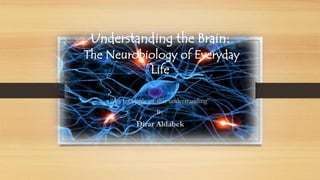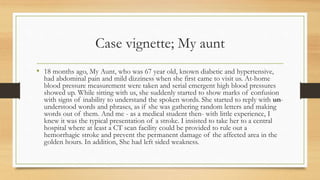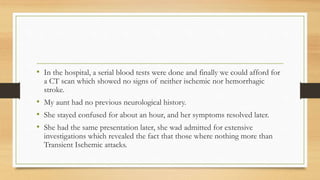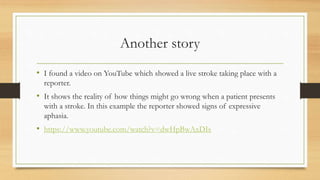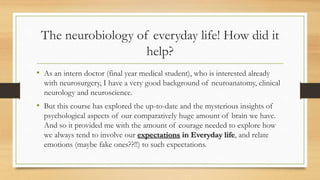Neurobiology of everyday life
- 1. Understanding the Brain: The Neurobiology of Everyday Life “An Example of this understanding” By Dirar Aldabek
- 2. Crieteria to be met • Parts of the nervous system that are active in my example are: neo-cortex – Broca’s area and Wernicke’s area at least. • The function(s) of the nervous system that are apparent and/or impaired in my Example is speech production and understanding at least. Articulation of words was preserved. • In-detail ways in which this course has allowed me to better analyze the events and phenomena around me will be discussed later.
- 3. Case vignette; My aunt • 18 months ago, My Aunt, who was 67 year old, known diabetic and hypertensive, had abdominal pain and mild dizziness when she first came to visit us. At-home blood pressure measurement were taken and serial emergent high blood pressures showed up. While sitting with us, she suddenly started to show marks of confusion with signs of inability to understand the spoken words. She started to reply with un- understood words and phrases, as if she was gathering random letters and making words out of them. And me - as a medical student then- with little experience, I knew it was the typical presentation of a stroke. I insisted to take her to a central hospital where at least a CT scan facility could be provided to rule out a hemorrhagic stroke and prevent the permanent damage of the affected area in the golden hours. In addition, She had left sided weakness.
- 4. • In the hospital, a serial blood tests were done and finally we could afford for a CT scan which showed no signs of neither ischemic nor hemorrhagic stroke. • My aunt had no previous neurological history. • She stayed confused for about an hour, and her symptoms resolved later. • She had the same presentation later, she wad admitted for extensive investigations which revealed the fact that those where nothing more than Transient Ischemic attacks.
- 5. Another story • I found a video on YouTube which showed a live stroke taking place with a reporter. • It shows the reality of how things might go wrong when a patient presents with a stroke. In this example the reporter showed signs of expressive aphasia. • https://www.youtube.com/watch?v=dwHpBwAxDIs
- 6. The neurobiology of everyday life! How did it help? • As an intern doctor (final year medical student), who is interested already with neurosurgery, I have a very good background of neuroanatomy, clinical neurology and neuroscience. • But this course has explored the up-to-date and the mysterious insights of psychological aspects of our comparatively huge amount of brain we have. And so it provided me with the amount of courage needed to explore how we always tend to involve our expectations in Everyday life, and relate emotions (maybe fake ones??!!) to such expectations.
- 7. • In general, I have learned the very crucial basics of how to relate the everyday functions of our brain machinery with what to expect, and what I can give back.
- 8. Finally, • The insights of research topics presented in this course (such as the cerebellar functions in evaluating human emotions and its reciprocal role with the basal ganglia in decision making) has inspired me to looking forward more studying in such a field.

